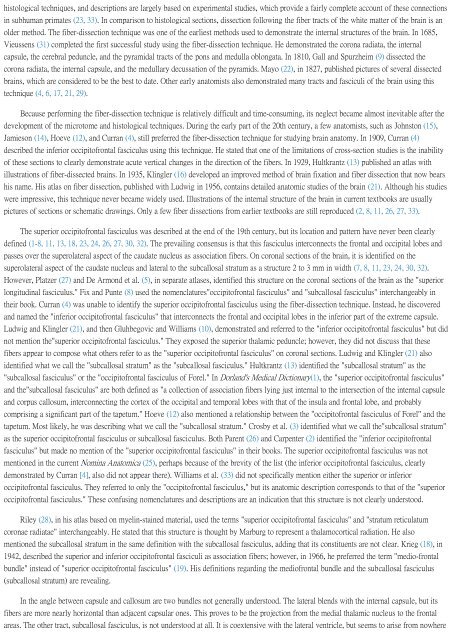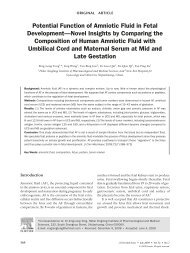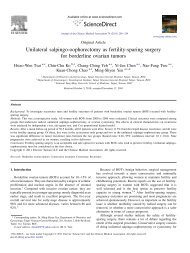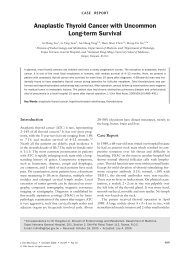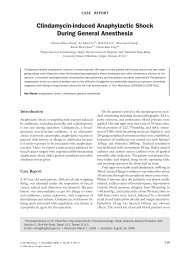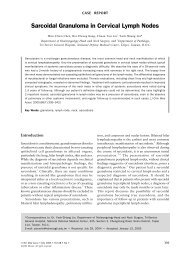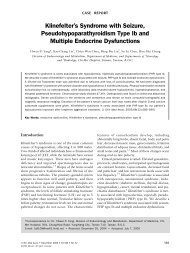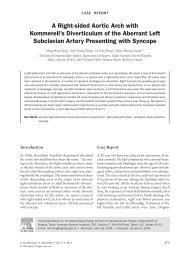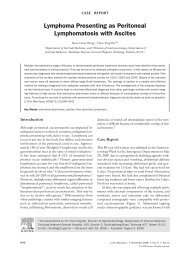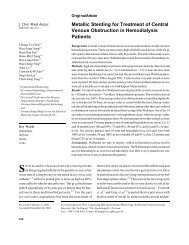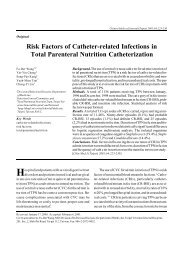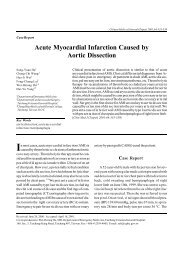Surgical Anatomy of Supratentorial Midline Lesions
Surgical Anatomy of Supratentorial Midline Lesions
Surgical Anatomy of Supratentorial Midline Lesions
Create successful ePaper yourself
Turn your PDF publications into a flip-book with our unique Google optimized e-Paper software.
histological techniques, and descriptions are largely based on experimental studies, which provide a fairly complete account <strong>of</strong> these connections<br />
in subhuman primates (23, 33). In comparison to histological sections, dissection following the fiber tracts <strong>of</strong> the white matter <strong>of</strong> the brain is an<br />
older method. The fiber-dissection technique was one <strong>of</strong> the earliest methods used to demonstrate the internal structures <strong>of</strong> the brain. In 1685,<br />
Vieussens (31) completed the first successful study using the fiber-dissection technique. He demonstrated the corona radiata, the internal<br />
capsule, the cerebral peduncle, and the pyramidal tracts <strong>of</strong> the pons and medulla oblongata. In 1810, Gall and Spurzheim (9) dissected the<br />
corona radiata, the internal capsule, and the medullary decussation <strong>of</strong> the pyramids. Mayo (22), in 1827, published pictures <strong>of</strong> several dissected<br />
brains, which are considered to be the best to date. Other early anatomists also demonstrated many tracts and fasciculi <strong>of</strong> the brain using this<br />
technique (4, 6, 17, 21, 29).<br />
Because performing the fiber-dissection technique is relatively difficult and time-consuming, its neglect became almost inevitable after the<br />
development <strong>of</strong> the microtome and histological techniques. During the early part <strong>of</strong> the 20th century, a few anatomists, such as Johnston (15),<br />
Jamieson (14), Hoeve (12), and Curran (4), still preferred the fiber-dissection technique for studying brain anatomy. In 1909, Curran (4)<br />
described the inferior occipit<strong>of</strong>rontal fasciculus using this technique. He stated that one <strong>of</strong> the limitations <strong>of</strong> cross-section studies is the inability<br />
<strong>of</strong> these sections to clearly demonstrate acute vertical changes in the direction <strong>of</strong> the fibers. In 1929, Hultkrantz (13) published an atlas with<br />
illustrations <strong>of</strong> fiber-dissected brains. In 1935, Klingler (16) developed an improved method <strong>of</strong> brain fixation and fiber dissection that now bears<br />
his name. His atlas on fiber dissection, published with Ludwig in 1956, contains detailed anatomic studies <strong>of</strong> the brain (21). Although his studies<br />
were impressive, this technique never became widely used. Illustrations <strong>of</strong> the internal structure <strong>of</strong> the brain in current textbooks are usually<br />
pictures <strong>of</strong> sections or schematic drawings. Only a few fiber dissections from earlier textbooks are still reproduced (2, 8, 11, 26, 27, 33).<br />
The superior occipit<strong>of</strong>rontal fasciculus was described at the end <strong>of</strong> the 19th century, but its location and pattern have never been clearly<br />
defined (1-8, 11, 13, 18, 23, 24, 26, 27, 30, 32). The prevailing consensus is that this fasciculus interconnects the frontal and occipital lobes and<br />
passes over the superolateral aspect <strong>of</strong> the caudate nucleus as association fibers. On coronal sections <strong>of</strong> the brain, it is identified on the<br />
superolateral aspect <strong>of</strong> the caudate nucleus and lateral to the subcallosal stratum as a structure 2 to 3 mm in width (7, 8, 11, 23, 24, 30, 32).<br />
However, Platzer (27) and De Armond et al. (5), in separate atlases, identified this structure on the coronal sections <strong>of</strong> the brain as the "superior<br />
longitudinal fasciculus." Fix and Punte (8) used the nomenclatures"occipit<strong>of</strong>rontal fasciculus" and "subcallosal fasciculus" interchangeably in<br />
their book. Curran (4) was unable to identify the superior occipit<strong>of</strong>rontal fasciculus using the fiber-dissection technique. Instead, he discovered<br />
and named the "inferior occipit<strong>of</strong>rontal fasciculus" that interconnects the frontal and occipital lobes in the inferior part <strong>of</strong> the extreme capsule.<br />
Ludwig and Klingler (21), and then Gluhbegovic and Williams (10), demonstrated and referred to the "inferior occipit<strong>of</strong>rontal fasciculus" but did<br />
not mention the"superior occipit<strong>of</strong>rontal fasciculus." They exposed the superior thalamic peduncle; however, they did not discuss that these<br />
fibers appear to compose what others refer to as the "superior occipit<strong>of</strong>rontal fasciculus" on coronal sections. Ludwig and Klingler (21) also<br />
identified what we call the "subcallosal stratum" as the "subcallosal fasciculus." Hultkrantz (13) identified the "subcallosal stratum" as the<br />
"subcallosal fasciculus" or the "occipit<strong>of</strong>rontal fasciculus <strong>of</strong> Forel." In Dorland's Medical Dictionary(1), the "superior occipit<strong>of</strong>rontal fasciculus"<br />
and the"subcallosal fasciculus" are both defined as "a collection <strong>of</strong> association fibers lying just internal to the intersection <strong>of</strong> the internal capsule<br />
and corpus callosum, interconnecting the cortex <strong>of</strong> the occipital and temporal lobes with that <strong>of</strong> the insula and frontal lobe, and probably<br />
comprising a significant part <strong>of</strong> the tapetum." Hoeve (12) also mentioned a relationship between the "occipit<strong>of</strong>rontal fasciculus <strong>of</strong> Forel" and the<br />
tapetum. Most likely, he was describing what we call the "subcallosal stratum." Crosby et al. (3) identified what we call the"subcallosal stratum"<br />
as the superior occipit<strong>of</strong>rontal fasciculus or subcallosal fasciculus. Both Parent (26) and Carpenter (2) identified the "inferior occipit<strong>of</strong>rontal<br />
fasciculus" but made no mention <strong>of</strong> the "superior occipit<strong>of</strong>rontal fasciculus" in their books. The superior occipit<strong>of</strong>rontal fasciculus was not<br />
mentioned in the current Nomina Anatomica (25), perhaps because <strong>of</strong> the brevity <strong>of</strong> the list (the inferior occipit<strong>of</strong>rontal fasciculus, clearly<br />
demonstrated by Curran [4], also did not appear there). Williams et al. (33) did not specifically mention either the superior or inferior<br />
occipit<strong>of</strong>rontal fasciculus. They referred to only the "occipit<strong>of</strong>rontal fasciculus," but its anatomic description corresponds to that <strong>of</strong> the "superior<br />
occipit<strong>of</strong>rontal fasciculus." These confusing nomenclatures and descriptions are an indication that this structure is not clearly understood.<br />
Riley (28), in his atlas based on myelin-stained material, used the terms "superior occipit<strong>of</strong>rontal fasciculus" and "stratum reticulatum<br />
coronae radiatae" interchangeably. He stated that this structure is thought by Marburg to represent a thalamocortical radiation. He also<br />
mentioned the subcallosal stratum in the same definition with the subcallosal fasciculus, adding that its constituents are not clear. Krieg (18), in<br />
1942, described the superior and inferior occipit<strong>of</strong>rontal fasciculi as association fibers; however, in 1966, he preferred the term "medio-frontal<br />
bundle" instead <strong>of</strong> "superior occipit<strong>of</strong>rontal fasciculus" (19). His definitions regarding the medi<strong>of</strong>rontal bundle and the subcallosal fasciculus<br />
(subcallosal stratum) are revealing.<br />
In the angle between capsule and callosum are two bundles not generally understood. The lateral blends with the internal capsule, but its<br />
fibers are more nearly horizontal than adjacent capsular ones. This proves to be the projection from the medial thalamic nucleus to the frontal<br />
areas. The other tract, subcallosal fasciculus, is not understood at all. It is coextensive with the lateral ventricle, but seems to arise from nowhere


